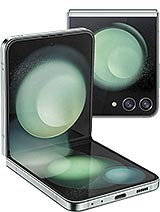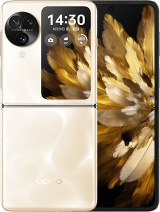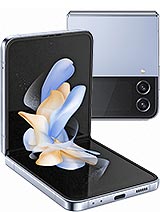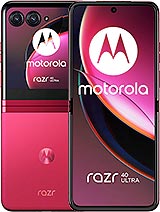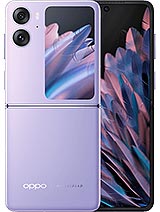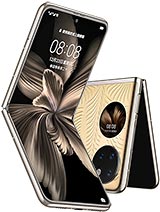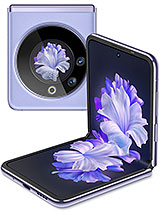Oppo Find N3 Flip review

Android 13, ColorOS 13, widgets on the cover screen
The Find N3 Flip runs Android 13, with an in-house layer of ColorOS on top, v.13.2. Oppo has promised 4 years of major updates and 5 years of security patches, which is a most welcome development.

But before we get to the main UI, let's talk about the cover screen's capabilities. You can have an always-on display on there, with a whole lot of different clock styles, color options and other settings (date and notifications are optional, for example).
You can add various widgets here, which are quite similar to the ones we've seen on lockscreen of Apple's iOS.
A good old wallpaper can also be used, of course.
The interactive pets have been updated with cooler pets and even cooler animation. This pet clock style displays an animal that lives on the lockscreen, past the AoD. You get to choose between eight animals, and they'll be doing something different every time you wake up the cover screen (well, not every time, but they do change their activities). Tapping on the animal will make it react in some way. Thankfully, you don't need to feed them or care for them in any way.
You can wake the cover screen with a double tap and send it back to sleep the same way. The only option for unlocking is with the fingerprint, and if for any reason you max out the unsuccessful attempts, you need to either wait 30 seconds or open the Flip and use whatever backup method you have set up inside. We'd say there's plenty of room on the cover screen for either a numpad or drawing an unlock pattern, and we wonder why these options don't exist there.

And you need to unlock the screen in order to be able to pull down from the top to access the quick toggles or pull up from the bottom to get to the notifications. Both of these can normally be done without unlocking on most phones, so it's a weird distinction that the cover screen here requires it.
You can toggle settings on or off, but there doesn't appear to be a way to rearrange them or to replace the default ones. Also, you can't change the Wi-Fi network from here, it's just on or off. That said, we may be overly critical here - the quick toggles allow quick basic actions without needing to open the phone, and more complex operations will likely require a keyboard or more screen estate. It's also a nice touch that hitting the flashlight toggle doesn't immediately light up the LEDs at your face but gives you a 3s delay.

Similarly, you get a basic interaction option for your notifications with predefined quick replies where available - essentially the expanded view you'd see on a normal phone if you tap on the arrow to the right of the notification card.




Lockscreen • Quick toggles • Notifications • Weather
Past this lockscreen, there isn't a full-fledged UI, but rather a selection of compatible mini apps. The available from the system are Camera, Weather, Timer, Events, Wireless Earphones, To-Dos, Alarms, Spotify, Calculator, Recorder and GameSnacks app that is full of small games.
There is also a Lab section, where you can enable even more apps like all Google-made apps (Maps and Wallet included), Netflix, YouTube, YouTube Music, TikTok. And we are talking about their full-blown versions, not some limited functionality.
But wait, there is more! You can also go to Other supported apps and find even more compatible apps that would run in mini mode like Strava, Nike Run Clun, MyFitnessPal, Telegram, X, Reddit, Outlook, among others.




All compatible apps that can run on the cover screen
As for the intricacies of the camera app on the outer screen, we've covered those in the camera section of the review on the next page.
And now for some more casual ColorOS 13 stuff. There is an entire Wallpapers & style page in Settings, where in addition to the AoD settings, you can change wallpapers (live and static), switch to different icon packs, different quick toggles icon shapes, change fonts (there's an 'exclusive' Oppo sans), and choose completely different colors that will change the entire UI look. You can even turn on/off Edge Lighting, which is independent of the Always-On Display.
The launcher has regular homescreens, a simplistic and clean notification/toggles area, and an easy-to-use task switcher. An App drawer is available, too, and it is as clutter-free as one could hope for. You can opt out of the app drawer if you prefer.






Lockscreen • Homescreen • Google Discover • Notifications • Quick toggles • Task switcher
The launcher supports Large Folders and Dynamic Widgets. Any folder can be enlarged or shrunk. Split-screen and Floating Window types of multi-tasking are available.
There are many powerful tools within the settings menu if you want full control over your Find N3 Flip. The features are wide-ranging but generally carried over from previous ColorOS versions. A host of screen-on and screen-off gestures are available, the Smart Sidebar is a handy pane of shortcuts you pull from the side, split-screen and Flexible windows are available.
Multimedia apps such as Photos, Music, and Videos all come courtesy of ColorOS. There is also a revamped File Manager and a Phone Manager app to keep track of battery, storage, app permissions, and whatnot.






Photos • Music • Videos • File Manager • Phone Manager
ColorOS also includes the Zen Space app to help you focus without the phone distracting you by simply preventing you from using it. There are a few predefined modes such as Deep Zen, Light Zen, Work, Study, but you can make your own thing, too.
There's also the O Relax app, which includes a variety of comforting music tracks and ambient nature sounds to relax.






Zen Space • Zen Space • Zen Space • O Relax • O Relax • O Relax
Finally, there is also a dedicated Games center with a special performance mode, game toolkit, and granular game management. There are some new features like the Championship mode and music playback control.
The Find N3 Flip supports a semi-opened state. The phone is aware that it is in this state and lets the Android OS and any running app know. In this sense, a special UI will trigger behavior already baked into modern versions of Android, specifically designed to make apps more aware of the current state of foldable displays, allowing them to adapt their UI.

So far, we found it to work only on YouTube and within the Camera app.
Performance and benchmarks
The Oppo Find N3 Flip employs the top-of-the-line Dimensity 9200 chipset. It is fabbed on the 2nd Gen TSMC 4nm process (N4P) and brings plenty of improvements over the Dimensity 9000 inside the N2 Flip.
The Dimensity 9200 chipset features an octa-core processor with newer core models - there is a prime Cortex-X3 core @ 3.05Hz, 3x Cortex-A715 cores @ 2.85GHz and 4x Cortex-A510 @ 1.8GHz.
The SoC utilizes the ARM Immortalis-G715 MC11 GPU with hardware-based ray tracing engine. The new flagship graphics unit brings Variable Rate Shading (VRS), double machine learning performance compared to the predecessor and ARM Fixed Rate Compression (AFRC) for reduced bandwidth usage.
MediaTek is also bringing a sixth-generation AI Processing Unit - the APU 690, which brings a 35% improvement over its predecessor in the ETHZ5.0 benchmark app. The chipset also enables support for speedy LPDDR5X RAM with support for up to 8,533Mbps memory and UFS 4.0 storage for blazing-fast data transmission and direct storage access to the CPU cores.
The Oppo Find N3 Flip we have for this review packs 12GB of LPDDR5X RAM and 256GB UFS 4.0 storage. A 512GB version is also in circulation.
And now, let's run some benchmarks.
The Find N3 Flip has this High Performance Battery mod, just like other ColorOS-running phones. We tested the Flip in both its default state and in 'High Performance' mode. The latter allows the CPU to run at its full potential with little consideration for battery efficiency and higher thermal thresholds. The 'regular' mode (not a setting, strictly speaking, just with 'High performance' turned off) imposes some limitations on the processor, and the phone returns CPU benchmark scores lower than the expected for the Dimensity 9200. The GPU isn't affected by this, and it's always working at full power.

The default CPU scores are lower on the N3 Flip than on phones with a similarly powerful chipset (Snapdragon 8+ Gen 1, vivo X Flip). But using the High Performance mode allows the CPU to reach the same scores.
Unfortunately, BBK phones cannot do High Frame Rate gaming and the Find N3 Flip is no different. All games and benchmarks are capped at 60FPS unless a special partnership or boost has been arranged between the developer and Oppo.
Other than that, the Dimensity 9200 GPU is only bested by the one inside the Snapdragon 8 Gen 2, meaning the phone has as flagship hardware as it can get.
Finally, the AnTuTu scores are great, though a bit lower than the competition's when not using the High Performance mode.
The Oppo Find N3 Flip has one of the best chipsets on the market and it will allow it to exceed in everything you can throw at it.
The phone did not heat up during any of these benchmarks, it didn't even become that warm, which is yet another aspect we can praise.
That is, of course, because the Flip 3 throttles the performance when necessary. Our CPU stability test revealed that the OS limits the CPU power down to 67% after 15 minutes of peak performance. That is in line with other compact foldables, which are typically extremely overcrowded on the inside.
The GPU throttling is even harsher - down to 38%. While that is a huge drop, it is also in line with phones of similar build and power. The Dimensity 9000 inside the Find N2 though had much better stability - 80% for CPU and 57% for GPU, but let's not forget that's a less powerful SoC.
Overall, the Find N3 Flip is a powerful smartphone with top-notch performance, but its stability isn't impressive due to overheating prevention methods. The phone never throttled outside our stability testing, even after playing a regular game for straight 5 hours, but we suspect a more intensive action game, especially multi-player ones, will require some tweaking for long sessions.
Reader comments
- santosh
- 06 Feb 2025
- XpV
OPPO Find N3’s “Premium Service” is a Complete Disaster – No Support for 2 Weeks! I am beyond frustrated and disappointed with OPPO’s so-called “premium service support” for the OPPO Find N3. The service has been nothing short of a nightmare—zero a...
- YUKI93
- 21 Dec 2024
- K1F
I definitely hope the next Find N5 Flip ditches the circular camera island and goes back to a vertical camera layout like in the Find N2 Flip. I think Oppo are on to something with the outer screen design, especially when it has a near 16:9 aspect ra...
- Anonymous
- 02 Jan 2024
- PII
Can



























































